|
setSC-Cephalotus-5
|
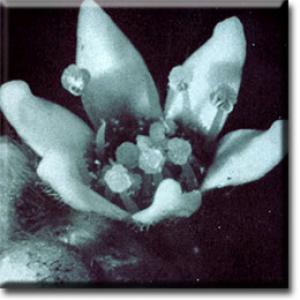
|
The flowers of Cephalotus are, in fact, somewhat like those of saxifrages. But DNA evidence has now revealed a slightly closer relationship--to Oxalis and its relatives. But it's still clearly in its own family.
|
copyright: Carlquist, BSA
license: - |
Image
|
Carnivorous Plants

|

|
|
setSC-Cephalotus-6
|
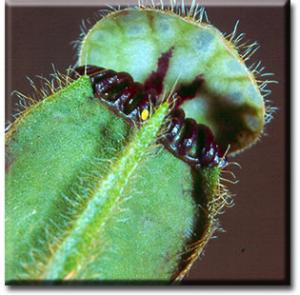
|
Viewed from the front, pitchers of Cephalotus have three wings, the middle one with a groove in it. The lid of the pitcher and the wings are hairy.
|
copyright: Carlquist, BSA
license: http://images.botany.org/index.html#license |
Image
|
Carnivorous Plants

|

|
|
setSC-Cephalotus-7
|
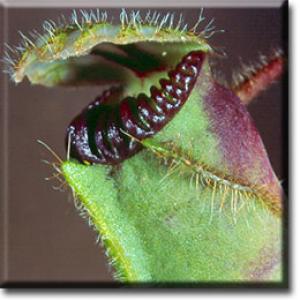
|
Seen from the side, pitchers of Cephalotus show that the lid is only a small distance above the mouth of the pitcher. The mouth of the pitcher is a dark red. A slender portion of the leaf, at right, connects the pitcher to the stem.
|
copyright: Carlquist, BSA
license: http://images.botany.org/index.html#license |
Image
|
Carnivorous Plants

|

|
|
setSC-Cephalotus-9
|
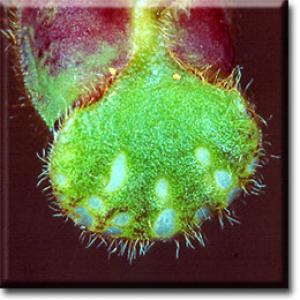
|
Viewed from the top of the pitcher, the nature of the lid is evident. There are translucent patches in the green tissue. If an insect is inside the pitcher and hasn't yet been caught in the liquid pool, it may fly upward, responding to the light it sees in these "windows" as though it were flying toward the sky....
|
copyright: Carlquist, BSA
license: http://images.botany.org/index.html#license |
Image
|
Carnivorous Plants

|

|
|
setSC-Darlingtonia_californica-1
|
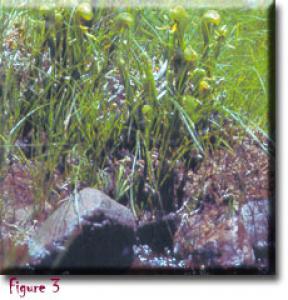
|
Darlingtonia californica grows along stream sides and in bogs in northern California and adjacent parts of Oregon. Although the distribution of Darlingtonia is somewhat similar to the distribution of serpentine rocks in these areas, they aren't identical at all. Darlingtonia doesn't appear restricted to the serpentine sites, but it does appear to grow well in areas rich in heavy metals.
|
copyright: Carlquist, BSA
license: http://images.botany.org/index.html#license |
Image
|
Carnivorous Plants

|

|
|
setSC-Darlingtonia_californica-10
|
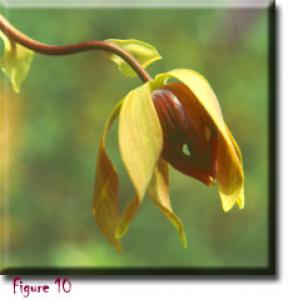
|
The flowers of Darlingtonia point downwards. This may keep rain out of the flowers; wet flowers usually don't get pollinated. The sepals are large and yellow-green. The petals seem almost hidden--they're dark purple.
|
copyright: Carlquist, BSA
license: http://images.botany.org/index.html#license |
Image
|
Carnivorous Plants

|

|
|
setSC-Darlingtonia_californica-11
|
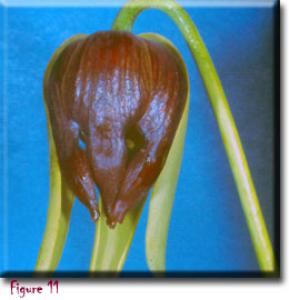
|
By removing some sepals, we can see the unusual nature of the petals. There are some pale translucent areas on the petals--these transmit some light to the inside of the flower, and perhaps a pollinating insect can find its way into the flower better. Also notice there are some spaces between the petals, elliptical openings through which an insect could enter....but what kind of insect?
|
copyright: Carlquist, BSA
license: http://images.botany.org/index.html#license |
Image
|
Carnivorous Plants

|

|
|
setSC-Darlingtonia_californica-12
|
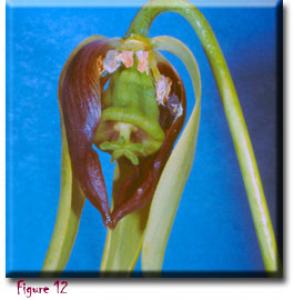
|
Actually, nobody knows what pollinates Darlingtonia flowers! One worker who watched the flowers didn't see any insects visiting the flowers. In various kinds of flowers, the shapes, colors, and patterns are usually closely related to the pollinators.
|
copyright: Carlquist, BSA
license: http://images.botany.org/index.html#license |
Image
|
Carnivorous Plants

|

|
|
setSC-Darlingtonia_californica-13
|
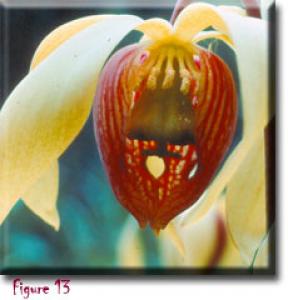
|
If we remove a sepal and a petal, we can see the inside of the flower as an insect might see it. Notice one of the openings between two petals through which in insect might enter--and the translucent spots in the petals show up well in this daylight photograph. Several things about the Darlingtonia flower suggests that a beetle might visit it--but remember, nobody knows yet.
|
copyright: Carlquist, BSA
license: http://images.botany.org/index.html#license |
Image
|
Carnivorous Plants

|

|
|
setSC-Darlingtonia_californica-14
|

|
If we look at flowering plants of the world, those pollinated by beetles are frequently dark purple and green. Bees don't pay attention to those colors. Some flowers that are pollinated by beetles have trap-like shapes--and the flowers of Darlingtonia fit that description. The reason why beetle-pollinated flowers have a trap-like shape is that beetles don't fly in and out of flowers very efficiently--beetles tend to stay in flowers and feed on flower parts. By bumbling around inside a flower, beetles can pick up a lot of pollen or deposit it on the pollen-collecting surfaces, the stigmas (the forklike structures in this picture). The longer a beetle stays inside a flower, the more likely it is to pollinate the flower.
|
copyright: Carlquist, BSA
license: http://images.botany.org/index.html#license |
Image
|
Carnivorous Plants

|

|
|
setSC-Darlingtonia_californica-15
|
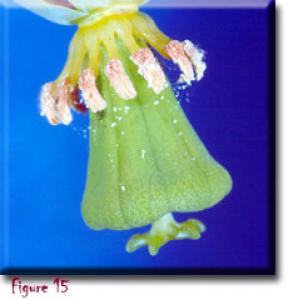
|
Beetle-pollinated flowers don't have nectar, whereas flowers pollinated by bees, flies, and birds do have nectar. Darlingtonia flowers have no apparent nectar, so that would fit the beetle idea. Beetles like to eat pollen--and as you can see, Darlingtonia flowers produce lots of pollen, which the flower is shedding here from its pale yellow stamens, shown above. If beetles eat the pollen, wouldn't that be bad for pollination? No, it's a compromise. Beetle-pollinated flowers produce plenty of pollen, and beetles aren't very efficient feeders, so there always seems to be plenty of pollen left over for a beetle to carry around on its surfaces, transferring that pollen to another flower.
|
copyright: Carlquist, BSA
license: http://images.botany.org/index.html#license |
Image
|
Carnivorous Plants

|

|
|
setSC-Darlingtonia_californica-16
|
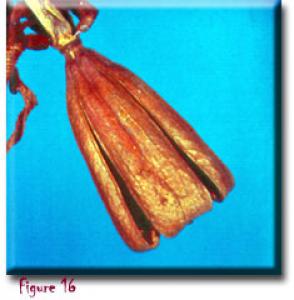
|
After pollination occurs, the fruit expands and turns brown when it matures. Some splits occur in the sides of the fruits, and some of the seeds might be dispersed through those splits.
|
copyright: Carlquist, BSA
license: http://images.botany.org/index.html#license |
Image
|
Carnivorous Plants

|

|
|
setSC-Darlingtonia_californica-17
|
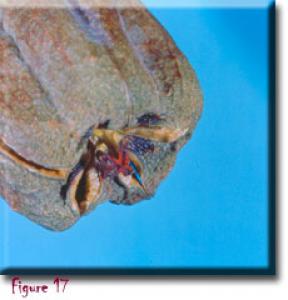
|
But more likely, the seeds escape through some openings at the end of the fruit. Notice they mouth-like openings at the end of the fruit. These close up if the fruit gets wet during the rain, but they open ujp when the weather is dry and windy. This suggests that the seeds are dispersed by wind. The fruit of Darlingtonia is like a shaker--only a few seeds escape at a time, because the mouth-like openings are small. This benefits the plant, because dispersing seeds over a period of weeks means that the seeds will reach more places. Also, more seeds are dispersed on a windy day, because more seeds sift out through the openings. If seeds of a plant are wind-dispersed, a mechanism like this that disperses more seeds on a windier day is better, because the seeds will be carried farther, and Darlingtonia seeds could reach distant places where it could grow well.
|
copyright: Carlquist, BSA
license: http://images.botany.org/index.html#license |
Image
|
Carnivorous Plants

|

|
|
setSC-Darlingtonia_californica-18
|
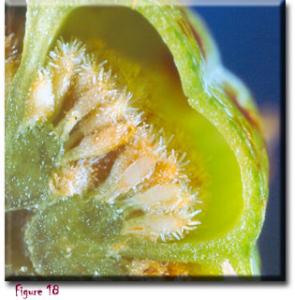
|
18Here's what the seeds look like just before they mature. This is a cross-section of a fruit. The seeds are still attached to the central part of the fruit. When the seeds mature, they break away from the center of the fruit and gradually fall out through the openings shown in the previous picture. The places where Darlingtonia can grow--streams and bogs--are only small areas. Small seeds carried by wind would reach these small, distant areas better than would bigger seeds.
|
copyright: Carlquist, BSA
license: http://images.botany.org/index.html#license |
Image
|
Carnivorous Plants

|

|
|
setSC-Darlingtonia_californica-19
|
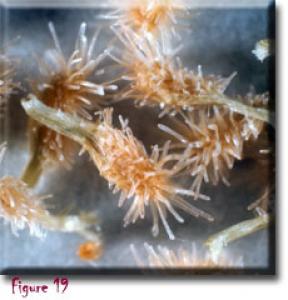
|
Mature Darlingtonia californica seeds.
|
copyright: Carlquist, BSA
license: http://images.botany.org/index.html#license |
Image
|
Carnivorous Plants

|

|
|
setSC-Darlingtonia_californica-2
|
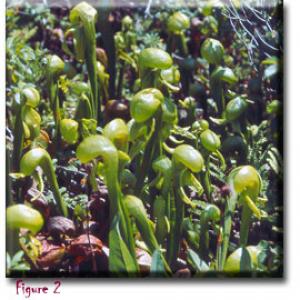
|
In a few flat boggy areas, one can see thousands of Darlingtonia plants. They prefer sunshine and don't grow well in shade. If you want to visit a large colony of Darlingtonia plants, there is one open to the public near Florence, Oregon, on the coast highway.
|
copyright: Carlquist, BSA
license: http://images.botany.org/index.html#license |
Image
|
Carnivorous Plants

|

|
|
setSC-Darlingtonia_californica-3
|
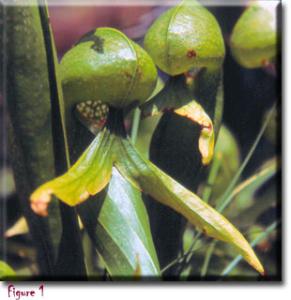
|
The leaf of Darlingtonia is unique: it is tubular, and contains a fluid that digests trapped insects. The upper part of the leaf, show here, is modified for the trapping function. The end of the leaf is hooded. There is a circular opening through which insects can fly into the hood. So why would they do so? One reason: on the two flag-like structures, there are glands that secrete sugary nectar, such as flies and other insects like to fed on. There are more nectar glands inside the hood, so an insect tends to progress right into the hood.
|
copyright: Carlquist, BSA
license: http://images.botany.org/index.html#license |
Image
|
Carnivorous Plants

|

|
|
setSC-Darlingtonia_californica-4
|
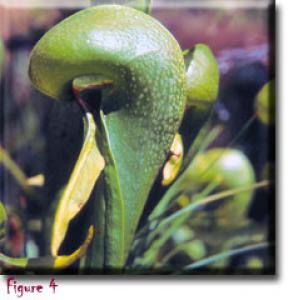
|
Here we can see the hood of a leaf with its flag-like appendages. Notice the circular opening through which insects enter the hood.
|
copyright: Carlquist, BSA
license: http://images.botany.org/index.html#license |
Image
|
Carnivorous Plants

|

|
|
setSC-Darlingtonia_californica-5
|
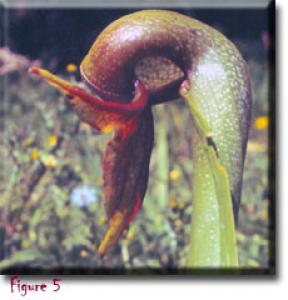
|
. Leaves of Darlingtonia often turn reddish-purple. This is a color that tends to attract flies and may aid in leading them to the leaves. Notice also that the hood has translucent areas in it, especially near the top of the hood. These have a clever purpose...
|
copyright: Carlquist, BSA
license: http://images.botany.org/index.html#license |
Image
|
Carnivorous Plants

|

|
|
setSC-Darlingtonia_californica-6
|
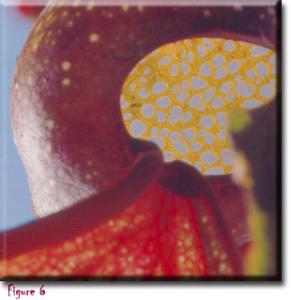
|
Now we see the hood the way an entering insect sees it, and a second reason for why an insect would enter is evident. The translucent windows in the leaf tissue look sky, so that the insect tends to fly upward thinking it is going outside of the hood...
|
copyright: Carlquist, BSA
license: http://images.botany.org/index.html#license |
Image
|
Carnivorous Plants

|

|